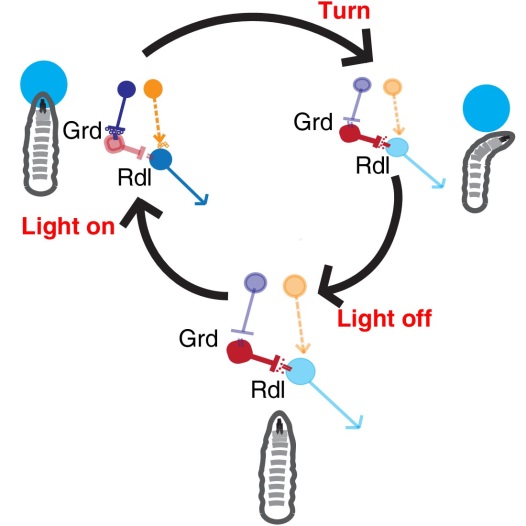Dr. Zhefeng Gong/'s group published in Nature Communications
On Jan 10, 2019, two groups led by Professor Zhefeng Gong and Associate Professor Nenggan Zheng, respectively from the Institute of Neuroscience and Qiushi Academy of Zhejiang University published their joint research article titled as “A disinhibitory mechanism biases Drosophila innate light preference” on Nature Communications. In this research, they discovered a key neural mechanism that controls Drosophila light avoidance behavior. A disinhibitory mechanism is utilized to realize the gating of avoidance maneuver elicited by light stimulation.
An important ability of an animal is that it can react to various environmental stimuli. How the animal nervous system transform the sensory input into specific behavioral output has long been a question asked by ethologists and physiologists. But the answer is not clear. To address this question, the authors carried out detailed investigation using Drosophila larval light avoidance as a model. By combing the tools of neural circuit tracing, single neuron imaging, optogentics and pharmacology, they found that Drosophila larva adopts a disinhibitory strategy to realized light avoidance. One pair of visual pathway neurons, the GABAergic LRINR13B07 neurons, can be constantly inhibited by light while they are able to inhibit downstream CLPNR82B09 neurons that command avoidance maneuver. When light is off, CLPNR82B09 neurons are inhibited. When larva receives light stimulation, the GABAergic LRINR13B07 neurons are inhibited so that their inhibition on CLPNR82B09 neurons is relieved. The latter neurons are then activated and generate an avoidance action. The authors used AI techniques such as computer vision and quantitatively analysis of the details of avoidance behavior, the authors not only confirmed that the disinhibitory circuit is necessary for normal light avoidance behavior, but also revealed that it is required for maintaining the success of avoidance. The disinhibitory mechanism underlying larval light avoidance response provides a nice clue for high-efficiency bionic modeling of sensorimotor process.
The first author of this paper is PhD student Weiqiao Zhao. The corresponding authors are Zhefeng Gong and Nenggan Zheng, respectively from Medical School and Qiushi Academy of Zhejiang University. This work was supported by basic research program of Ministry of Technology of China, Natural Science Foundation of China and the Natural Science Foundation of Zhejiang Province.
Link to the article: https://www.nature.com/articles/s41467-018-07929-w

A cartoon showing the hypothesized working mechanism of the disinhibitory pathway in larval light avoidance. The large light blue circles indicate light spots. The circles with arrows are red for LRINR13B07, green for CLPNR82B09, dark blue for clk-LexA labeled neurons and orange for unspecified excitatory neurons upstream of CLPNR82B09s, respectively. Arrow heads indicate excitatory input. Bar heads indicate inhibitory input. The thickness of arrows indicates the strength of the inhibitory or excitatory effects.







